Evaluation of the Effect of Fly Ash on Hydration Characterization in Self-Compacting Concrete (SCC) at Very Early Ages Using Piezoceramic Transducers
Abstract
1. Introduction
2. Smart Aggregate Based Active Sensing Approach
3. Wavelet Packet Energy Analysis
4. Specimens, Experiment Setup, and Procedures
4.1. SCC Concrete Specimens
4.1.1. Materials
Cement
Fly Ash
Coarse Aggregate
Fine Aggregates
Limestone Powder
Superplasticizer
4.1.2. Detailed Mix Proportions
4.1.3. Mixing Process
4.1.4. Flesh Properties of Concrete Mixture
4.2. Test Setup
4.2.1. Active Sensing Using Piezoceramic Transducers
4.2.2. Penetration Resistance Test
5. Experimental Results and Discussion
5.1. The Test Results Based on SAs
5.2. The Results of Penetration Resistance Test
5.3. Correlations of the Results from the Monitoring Based on SAs and the Penetration Resistance Tests
6. Conclusions
- (1)
- It is evident in the test results that using a high volume of fly ash as a replacement for cement has clear effects on the formation of the microstructures in SCC. Replacing cement by fly ash in SCC mixing decelerates the completion of hydration, which is attributed to the delayed start of the pozzolanic activity in microstructure of SCC.
- (2)
- By studying the amplitude of the propagated wave between a pair of embedded SAs, three hydration stages were clearly verified. In the liquid stage, the microstructure of the SCC changed steadily. The response of the signal provided by SAs was correspondingly stable. As the SCC entered the transition stage, the properties were changing dramatically. Thus, the voltage signals were enhanced significantly and the stress wave transmission through the hardening SCC became more intense. As a result, those signal responses were increased significantly after the initial setting. From the final setting time (hardened stage) and onwards, the hydration turned to the hardened stage and the amplitudes of the voltage signals became stable and steady, due to the smooth reaction in the microstructure of SCC.
- (3)
- The results of initial and final setting time of SCC test specimens predicted by the signal based on SAs showed good agreement with the results obtained from a series of penetration-resistance experimental tests. The results from those two experimental tests also revealed that the duration of the transition stage of SCCs were extended by increasing the volume of fly ash.
- (4)
- To quantitatively evaluate the hydration completion of SCCs with different volumes of fly ash, a normalized hydration completion index (NHCI) was proposed through a wavelet packet analysis. Based on the validation of the NHCI values with the test results of the penetration resistances, it was found that this index could offer an accurate assessment of the early-age hydration performance of SCCs.
Author Contributions
Funding
Conflicts of Interest
References
- Sonebi, M.; Bartos, P.J.M. Filling ability and plastic settlement of self-compacting concrete. Mater. Struct. 2002, 35, 462–469. [Google Scholar] [CrossRef]
- Kovler, K.; Roussel, N. Properties of fresh and hardened concrete. Cem. Concr. Res. 2011, 41, 775–792. [Google Scholar] [CrossRef]
- Khayat, K.H. Workability, testing, and performance of self-consolidating concrete. Mater. J. 1999, 96, 346–353. [Google Scholar]
- Madhavi, T.C.; Raju, L.S.; Mathur, D.; Madhavi, T.C.; Raju, L.S.; Mathur, D. Durabilty and Strength Properties of High Volume Fly Ash Concrete. J. Civ. Eng. Res. 2014, 4, 7–11. [Google Scholar]
- Dinakar, P.; Babu, K.G.; Santhanam, M. Durability properties of high volume fly ash self compacting concretes. Cem. Concr. Compos. 2008, 30, 880–886. [Google Scholar] [CrossRef]
- Dinakar, P.; Reddy, M.K.; Sharma, M. Behaviour of self compacting concrete using Portland pozzolana cement with different levels of fly ash. Mater. Des. 2013, 46, 609–616. [Google Scholar] [CrossRef]
- Durán-Herrera, A.; Juárez, C.A.; Valdez, P.; Bentz, D.P. Evaluation of sustainable high-volume fly ash concretes. Cem. Concr. Compos. 2011, 33, 39–45. [Google Scholar] [CrossRef]
- Zhou, L.; Zheng, Y.; Luo, Y.; Zhan, F.; Sun, C. Investigation of material properties of self-compacting concrete with high mixed volume of fly-ash. Concrete 2017, 11, 63–73. (In Chinese) [Google Scholar]
- Bouzoubaâ, N.; Zhang, M.H.; Malhotra, V.M. Mechanical properties and durability of concrete made with high-volume fly ash blended cements using a coarse fly ash. Cem. Concr. Res. 2001, 31, 1393–1402. [Google Scholar] [CrossRef]
- Atiş, C.D. Strength properties of high-volume fly ash roller compacted and workable concrete, and influence of curing condition. Cem. Concr. Res. 2005, 35, 1112–1121. [Google Scholar] [CrossRef]
- Weerdt, K.D.; Haha, M.B.; Saout, G.L.; Kjellsen, K.O.; Justnes, H.; Lothenbach, B. Hydration mechanisms of ternary Portland cements containing limestone powder and fly ash. Cem. Concr. Res. 2011, 41, 279–291. [Google Scholar] [CrossRef]
- Weerdt, K.D.; Kjellsen, K.O. Synergy between fly ash and limestone powder in ternary cements. Cem. Concr. Compos. 2011, 33, 30–38. [Google Scholar] [CrossRef]
- Berry, E.E.; Hemmings, R.T.; Cornelius, B.J. Mechanisms of hydration reactions in high volume fly ash pastes and mortars. Cem. Concr. Compos. 1990, 12, 253–261. [Google Scholar] [CrossRef]
- Branco, F.A.; Mendes, P.A.; Mirambell, E. Heat of hydration effects in concrete structures. Mater. J. 1992, 89, 139–145. [Google Scholar]
- Zou, X.; Wu, N.; Tian, Y.; Yu, T.Y.; Wang, X. Miniature fiber optic temperature sensor for concrete structural health monitoring. Proc. SPIE Int. Soc. Opt. Eng. 2012, 8345, 83454V. [Google Scholar]
- Xu, Q.; Ruiz, J.M.; Hu, J.; Wang, K.; Rasmussen, R.O. Modeling hydration properties and temperature developments of early-age concrete pavement using calorimetry tests. Thermochim. Acta 2011, 512, 76–85. [Google Scholar] [CrossRef]
- Voigt, T.; Grosse, C.U.; Sun, Z.; Shah, S.P.; Reinhardt, H.W. Comparison of ultrasonic wave transmission and reflection measurements with P- and S-waves on early age mortar and concrete. Mater. Struct. 2005, 38, 729–738. [Google Scholar] [CrossRef]
- Voigt, T.; Ye, G.; Sun, Z.; Shah, S.P.; Breugel, K.V. Early age microstructure of Portland cement mortar investigated by ultrasonic shear waves and numerical simulation. Cem. Concr. Res. 2005, 35, 858–866. [Google Scholar] [CrossRef]
- Reinhardt, H.W.; Grosse, C.U. Advanced testing of cement-based materials during setting and hardening. Phys. Res. Int. 2005, 2012, 65–88. [Google Scholar]
- Wang, T.; Song, G.; Wang, Z.; Li, Y. Proof-of-concept study of monitoring bolt connection status using a piezoelectric based active sensing method. Smart Mater. Struct. 2013, 22, 087001. [Google Scholar] [CrossRef]
- Shao, J.; Wang, T.; Yin, H.; Yang, D.; Li, Y. Bolt Looseness Detection Based on Piezoelectric Impedance Frequency Shift. Appl.Sci. 2016, 6, 298. [Google Scholar] [CrossRef]
- Jiang, T.; Kong, Q.; Wang, W.; Huo, L.; Song, G. Monitoring of Grouting Compactness in a Post-Tensioning Tendon Duct Using Piezoceramic Transducers. Sensors 2016, 16, 1343. [Google Scholar] [CrossRef] [PubMed]
- Feng, Q.; Kong, Q.; Jiang, J.; Liang, Y.; Song, G. Detection of Interfacial Debonding in a Rubber–Steel-Layered Structure Using Active Sensing Enabled by Embedded Piezoceramic Transducers. Sensors 2017, 17, 2001. [Google Scholar] [CrossRef] [PubMed]
- Huo, L.; Chen, D.; Liang, Y.; Li, H.; Feng, X.; Song, G. Impedance based bolt pre-load monitoring using piezoceramic smart washer. Smart Mater. Struct. 2017, 26, 057004. [Google Scholar] [CrossRef]
- Huo, L.; Wang, B.; Chen, D.; Song, G. Monitoring of Pre-Load on Rock Bolt Using Piezoceramic-Transducer Enabled Time Reversal Method. Sensors 2017, 17, 2467. [Google Scholar] [CrossRef] [PubMed]
- Mccarter, W.J. A parametric study of the impedance characteristics of cement-aggregate systems during early hydration. Cem. Concr. Res. 1994, 24, 1097–1110. [Google Scholar] [CrossRef]
- Talakokula, V.; Bhalla, S.; Gupta, A. Monitoring early hydration of reinforced concrete structures using structural parameters identified by piezo sensors via electromechanical impedance technique. Mech. Syst. Signal Proc. 2018, 99, 129–141. [Google Scholar] [CrossRef]
- Yang, Y.; Divsholi, B.S.; Soh, C.K. A Reusable PZT Transducer for Monitoring Initial Hydration and Structural Health of Concrete. Sensors 2010, 10, 5193–5208. [Google Scholar] [CrossRef] [PubMed]
- Tawie, R.; Lee, H.K. Impedance-based monitoring of bonding between steel rebar and concrete. Proc. SPIE 2010, 7647, 764721. [Google Scholar]
- Choi, S.K.; Tareen, N.; Kim, J.; Park, S.; Park, I. Real-Time Strength Monitoring for Concrete Structures Using EMI Technique Incorporating with Fuzzy Logic. Appl. Sci. 2018, 8, 75. [Google Scholar] [CrossRef]
- Kim, J.; Lee, C.; Park, S. Artificial Neural Network-Based Early-Age Concrete Strength Monitoring Using Dynamic Response Signals. Sensors 2017, 17, 1319. [Google Scholar] [CrossRef] [PubMed]
- Kim, J.W.; Lee, C.; Park, S.; Koh, K.T. Real-time strength development monitoring for concrete structures using wired and wireless electro-mechanical impedance techniques. KSCE J. Civ. Eng. 2013, 17, 1432–1436. [Google Scholar] [CrossRef]
- Gu, H. Health monitoring of a concrete structure using piezoceramic materials. Smart Struct. Mater. 2005, 2005, 108–119. [Google Scholar]
- Kong, Q.; Robert, R.; Silva, P.; Mo, Y.L. Cyclic Crack Monitoring of a Reinforced Concrete Column under Simulated Pseudo-Dynamic Loading Using Piezoceramic-Based Smart Aggregates. Appl. Sci. 2016, 6, 341. [Google Scholar] [CrossRef]
- Kong, Q.; Song, G. A Comparative Study of the Very Early Age Cement Hydration Monitoring using Compressive and Shear Mode Smart Aggregates. IEEE Sens. J. 2016, 17, 256–260. [Google Scholar] [CrossRef]
- Oh, T.; Kim, J.; Zhang, A.; Lee, C.; Park, S. Concrete strength evaluation in an early-age curing process using SVM with ultrasonic harmonic waves. Insight Non Destr. Test. Cond. Monit. 2016, 58, 609–616. [Google Scholar] [CrossRef]
- Yoon, H.; Kim, Y.J.; Kim, H.S.; Kang, J.W.; Koh, H.M. Evaluation of Early-Age Concrete Compressive Strength with Ultrasonic Sensors. Sensors 2017, 17, 1817. [Google Scholar] [CrossRef] [PubMed]
- Lee, C.; Park, S.; Bolander, J.E.; Pyo, S. Monitoring the hardening process of ultra high performance concrete using decomposed modes of guided waves. Constr. Build. Mater. 2018, 163, 267–276. [Google Scholar] [CrossRef]
- Kim, J.W.; Kim, J.; Park, S.; Oh, T.K. Integrating embedded piezoelectric sensors with continuous wavelet transforms for real-time concrete curing strength monitoring. Struct. Infrastruct. Eng. 2015, 11, 897–903. [Google Scholar] [CrossRef]
- Kong, Q.; Hou, S.; Ji, Q.; Mo, Y.L.; Song, G. Very early age concrete hydration characterization monitoring using piezoceramic based smart aggregates. Smart Mater. Struct. 2013, 22, 085025. [Google Scholar] [CrossRef]
- Zhu, J.; Tsai, Y.T.; Kee, S.H. Monitoring early age property of cement and concrete using piezoceramic bender elements. Smart Mater. Struct. 2011, 20, 115014. [Google Scholar] [CrossRef]
- Ravanfar, S.A.; Razak, H.A.; Ismail, Z.; Hakim, S.J.S. A Hybrid Procedure for Structural Damage Identification in Beam-Like Structures Using Wavelet Analysis. Adv. Struct. Eng. 2015, 18, 1901–1914. [Google Scholar] [CrossRef]
- Xu, B.; Zhang, T.; Song, G.; Gu, H. Active interface debonding detection of a concrete-filled steel tube with piezoelectric technologies using wavelet packet analysis. Mech. Syst. Signal Proc. 2013, 36, 7–17. [Google Scholar] [CrossRef]
- Sohn, H.; Park, G.; Wait, J.R.; Limback, N.P.; Farrar, C.R. Wavelet-based active sensing for delamination detection in composite structures. Smart Mater. Struct. 2003, 13, 153. [Google Scholar] [CrossRef]
- Du, G.; Kong, Q.; Zhou, H.; Gu, H. Multiple Cracks Detection in Pipeline Using Damage Index Matrix Based on Piezoceramic Transducer-Enabled Stress Wave Propagation. Sensors 2017, 17, 1812. [Google Scholar] [CrossRef] [PubMed]
- Zhang, L.; Wang, C.; Song, G. Health Status Monitoring of Cuplock Scaffold Joint Connection Based on Wavelet Packet Analysis. Shock Vib. 2015, 2015, 1–7. [Google Scholar] [CrossRef]
- Huo, L.; Chen, D.; Kong, Q.; Li, H.; Song, G. Smart washer—A piezoceramic-based transducer to monitor looseness of bolted connection. Smart Mater. Struct. 2017, 26, 025033. [Google Scholar] [CrossRef]
- Nagaratnam, B.H.; Faheem, A.; Rahman, M.E.; Mannan, M.A.; Leblouba, M. Mechanical and Durability Properties of Medium Strength Self-Compacting Concrete with High-Volume Fly Ash and Blended Aggregates. Period. Polytech. Civil. Eng. 2015, 59, 155–164. [Google Scholar] [CrossRef]
- Schutter, G.D.; Bartos, P.J.M.; Domone, P.; Gibbs, J. Self-Compacting Concrete; CRC Press: Boca Raton, FL, USA, 2008; pp. 821–828. [Google Scholar]
- Baert, G. Thermal analysis of cement-fly ash pastes. In Proceedings of the 5th International RILEM Symposium on Self-Compacting Concrete, Ghent, Belgium, 3–5 September 2007; pp. 583–588. [Google Scholar]
- MoHaU-RdotPsRo. Standard for Test Method of Performance on Ordinary Fresh Concrete. GB/T 50080-2016 Chinese National Standard. 1 April 2017. [Google Scholar]
- Heirman, G.; Vandewalle, L.; Gemert, D.V. Influence of mineral additions and chemical admixtures on setting and volumetric autogenous shrinkage of SCC-equivalent mortars. In Proceedings of the 5th International RILEM Symposium on Self-Compacting Concrete (SCC2007), Ghent, Belgium, 3–5 September 2007. [Google Scholar]
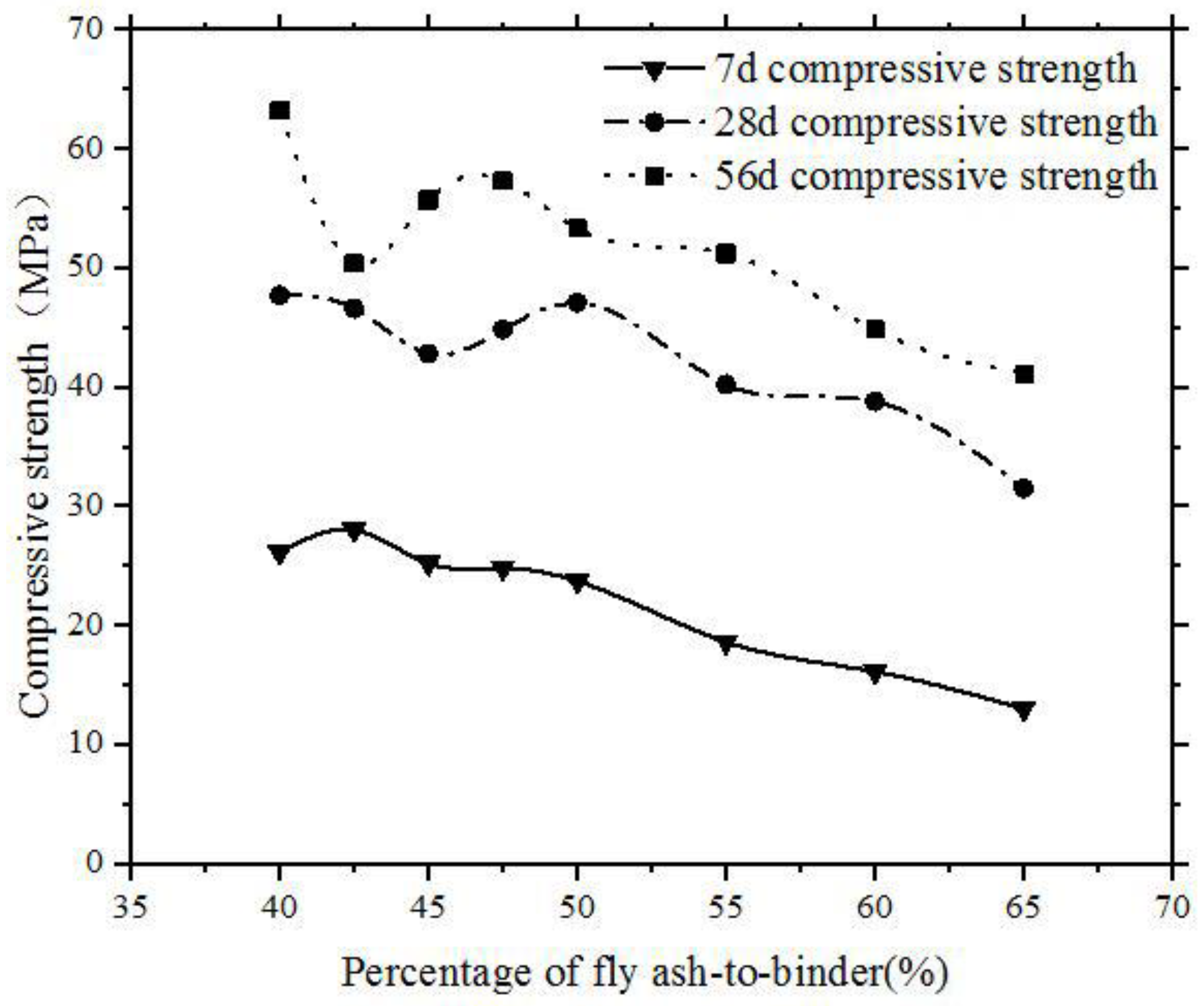
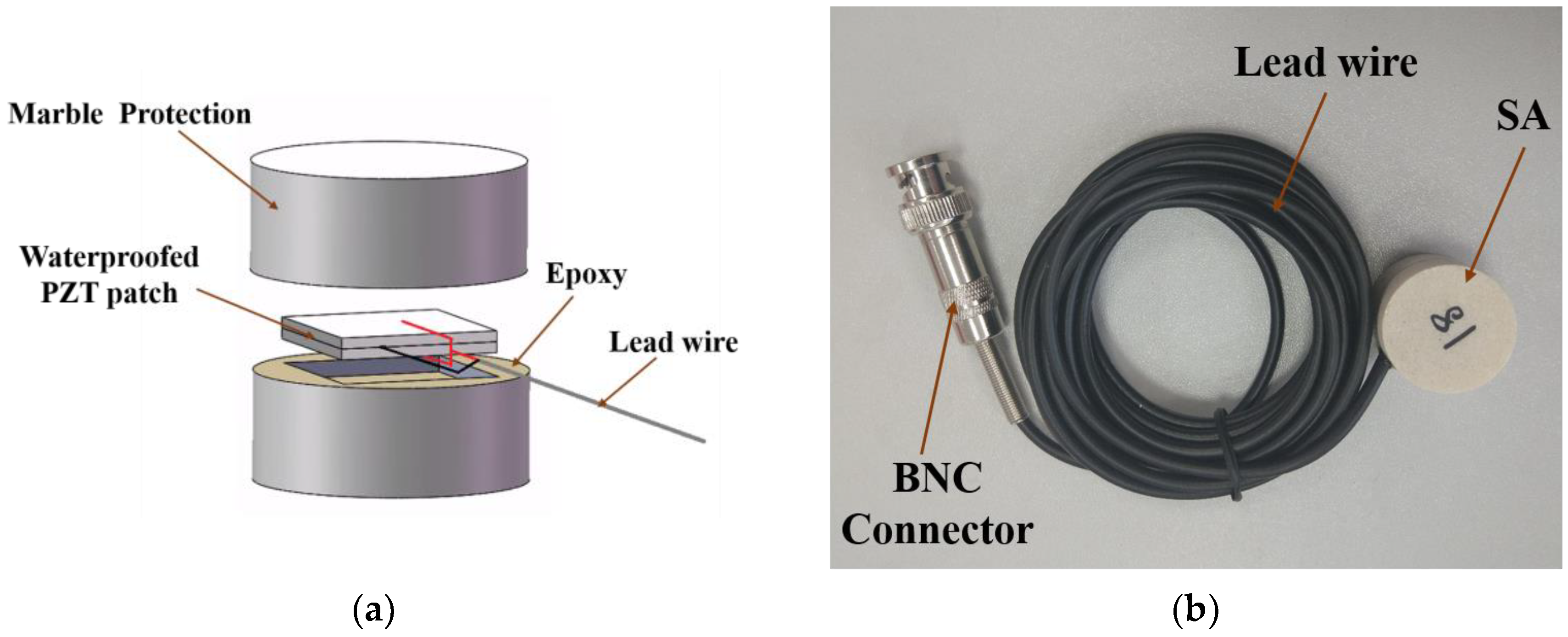









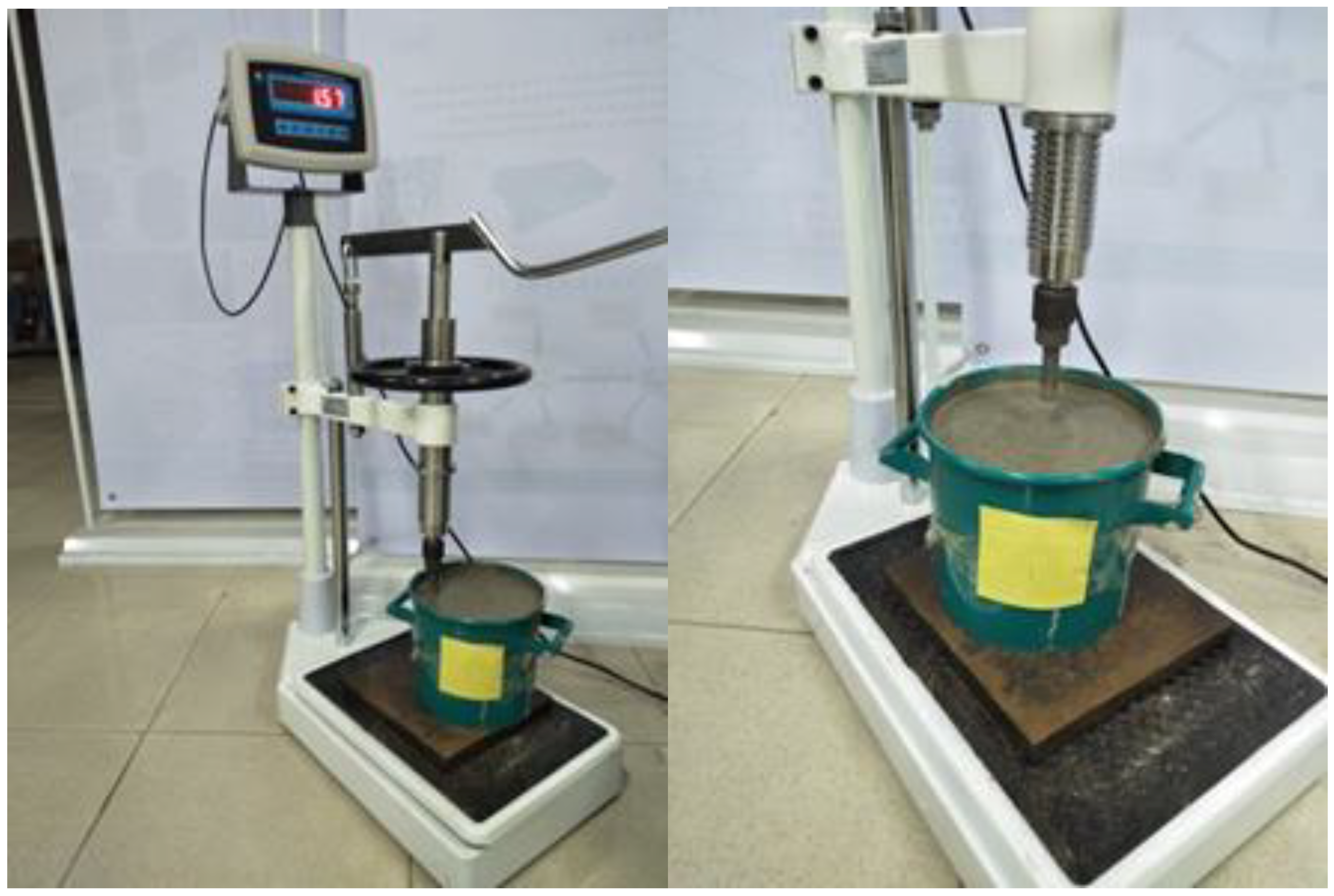




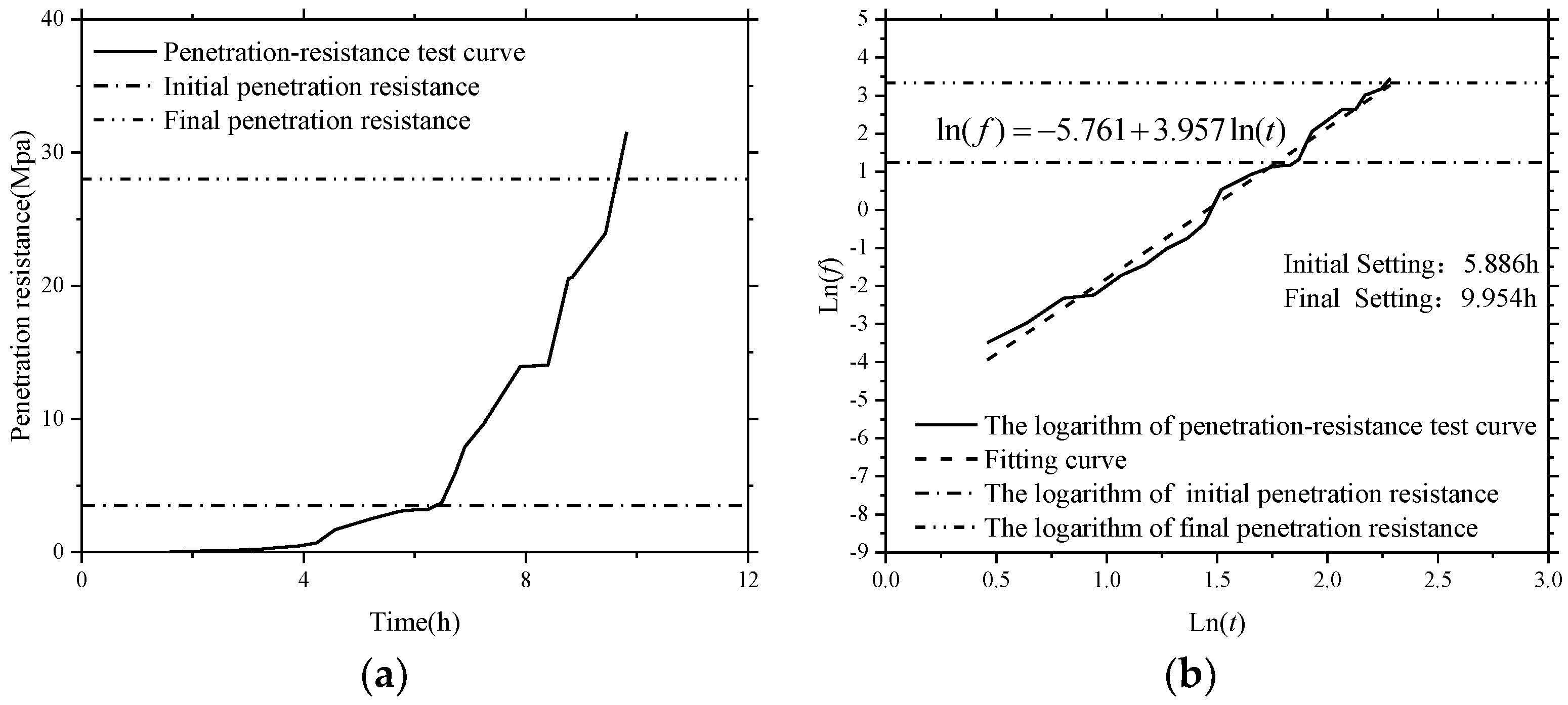
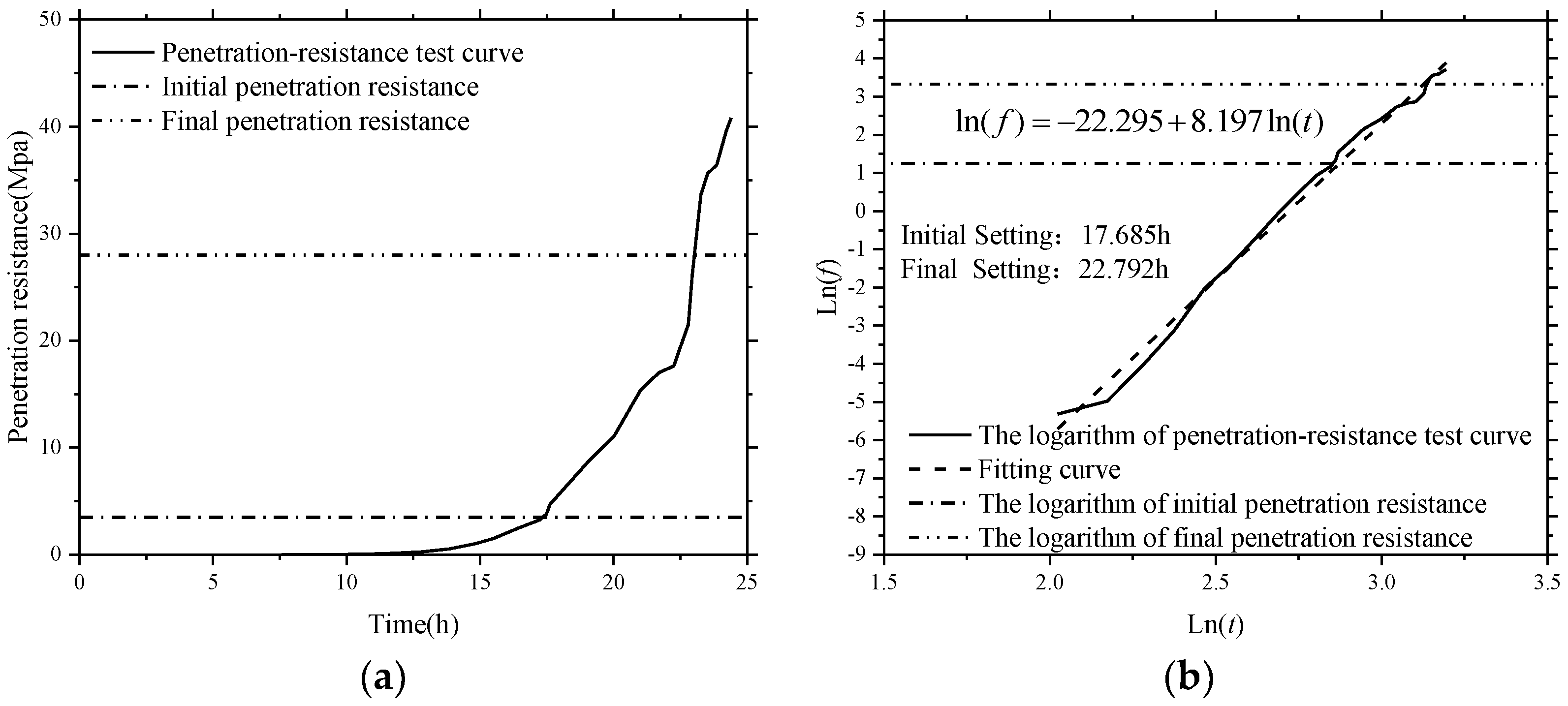

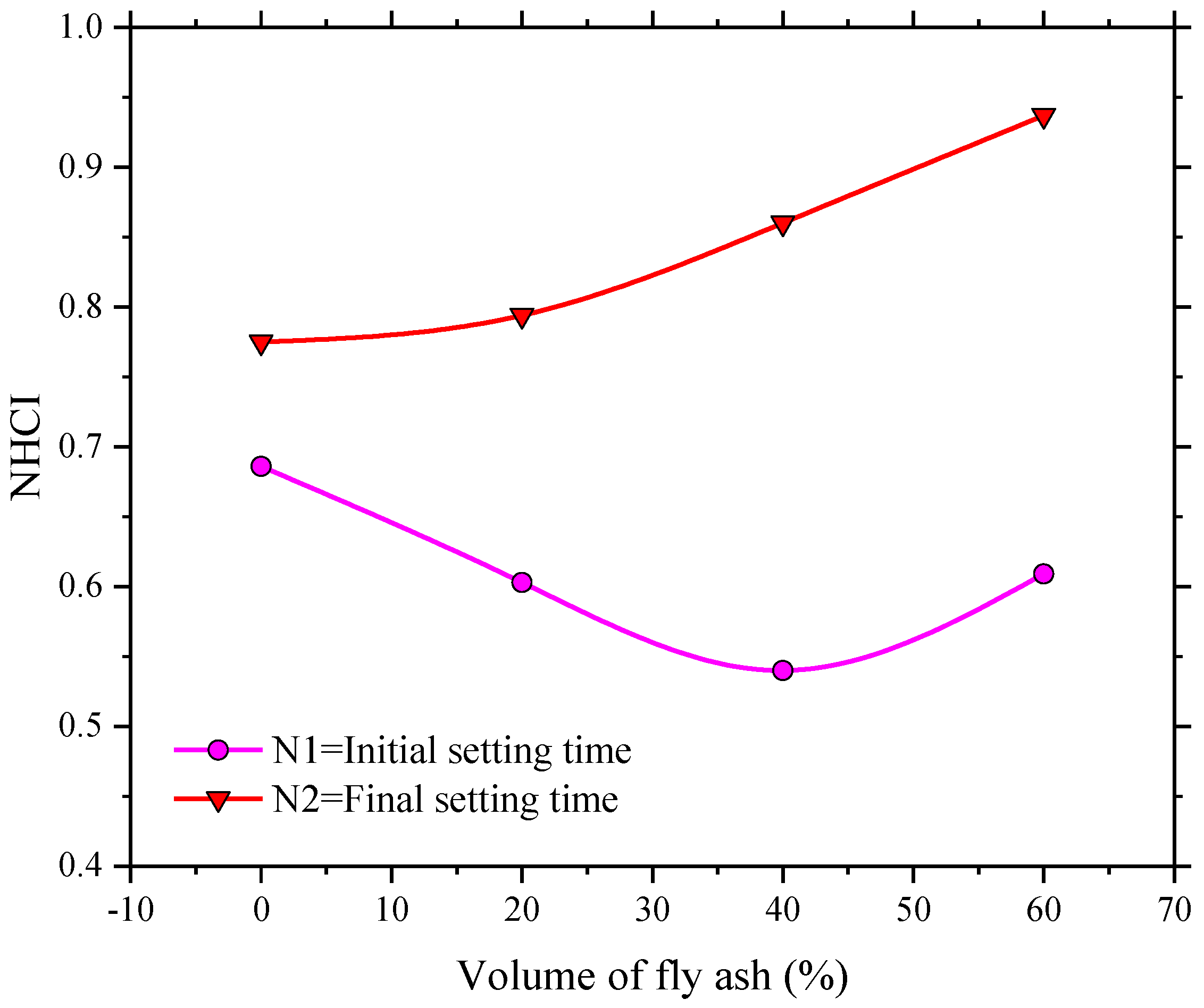

| Compound | SiO2 (%) | Fe2O3 (%) | CaO (%) | K2O (%) | SO3 (%) | TiO2 (%) | MnO2 (%) | SrO (%) |
|---|---|---|---|---|---|---|---|---|
| Fly ash | 60.7 | 18.7 | 10.2 | 4.3 | - | 4.1 | 0.4 | 0.7 |
| Cement | 13.8 | 6.0 | 75.7 | - | 3.7 | 0.4 | 0.2 | - |
| Coarse Aggregate | Fine Aggregate | ||
|---|---|---|---|
| Size of Sieve Aperture (mm) | Cumulative Sieve Residue (%) | Size of Sieve Aperture (mm) | Cumulative Sieve Residue (%) |
| 19.00 | 0.0 | 4.75 | 2.928 |
| 16.00 | 0.0 | 2.36 | 11.416 |
| 9.50 | 16.6 | 1.18 | 23.662 |
| 4.75 | 94.4 | 0.60 | 42.976 |
| 2.36 | 99.8 | 0.30 | 76.904 |
| bottom plate | 100.0 | 0.15 | 92.036 |
| bottom plate | 99.820 | ||
| Test Specimen | Coarse Aggregate (kg) | Fine Aggregate (kg) | Fly Ash (kg) | Cement (kg) | Limestone Powder (kg) | Water (kg) | Superplasticizer (%) |
|---|---|---|---|---|---|---|---|
| FA-0% | 56.183 | 56.611 | 0.000 | 36.479 | 5.785 | 14.513 | 0.16 |
| FA-20% | 56.183 | 56.611 | 8.453 | 28.026 | 5.785 | 14.513 | 0.16 |
| FA-40% | 56.183 | 56.611 | 16.906 | 19.573 | 5.785 | 14.513 | 0.16 |
| FA-60% | 56.183 | 56.611 | 25.358 | 11.121 | 5.785 | 14.513 | 0.16 |
| NO. | T500/(s) | Slump/(cm) | Slump Flow/(cm) | Cohesiveness | Bleeding | Segregation |
|---|---|---|---|---|---|---|
| FA-0% | - | 11.7 | 25.3 | Good | Not occurred | Not occurred |
| FA-20% | - | 25.1 | 41.9 | Good | Not occurred | Not occurred |
| FA-40% | 3 | - | 55.7 | Good | Not occurred | Not occurred |
| FA-60% | 2 | - | 73.2 | General | Not occurred | Not occurred |
| Start Frequency (Hz) | Stop Frequency (kHz) | Amplitude (V) | Duration (s) |
|---|---|---|---|
| 100 | 100 | 3 | 1 |
| Specimen | Initial Setting | Final Setting | ||
|---|---|---|---|---|
| SAs | Penetration Test | SAs | Penetration Test | |
| FA-0% | 4 | 5.9 | 7 | 10.0 |
| FA-20% | 8 | 7.8 | 11 | 10.8 |
| FA-40% | 11 | 13.2 | 16 | 17.4 |
| FA-60% | 16 | 17.7 | 21.5 | 22.8 |
© 2018 by the authors. Licensee MDPI, Basel, Switzerland. This article is an open access article distributed under the terms and conditions of the Creative Commons Attribution (CC BY) license (http://creativecommons.org/licenses/by/4.0/).
Share and Cite
Zheng, Y.; Chen, D.; Zhou, L.; Huo, L.; Ma, H.; Song, G. Evaluation of the Effect of Fly Ash on Hydration Characterization in Self-Compacting Concrete (SCC) at Very Early Ages Using Piezoceramic Transducers. Sensors 2018, 18, 2489. https://doi.org/10.3390/s18082489
Zheng Y, Chen D, Zhou L, Huo L, Ma H, Song G. Evaluation of the Effect of Fly Ash on Hydration Characterization in Self-Compacting Concrete (SCC) at Very Early Ages Using Piezoceramic Transducers. Sensors. 2018; 18(8):2489. https://doi.org/10.3390/s18082489
Chicago/Turabian StyleZheng, Yu, Dongdong Chen, Lingzhu Zhou, Linsheng Huo, Hongwei Ma, and Gangbing Song. 2018. "Evaluation of the Effect of Fly Ash on Hydration Characterization in Self-Compacting Concrete (SCC) at Very Early Ages Using Piezoceramic Transducers" Sensors 18, no. 8: 2489. https://doi.org/10.3390/s18082489
APA StyleZheng, Y., Chen, D., Zhou, L., Huo, L., Ma, H., & Song, G. (2018). Evaluation of the Effect of Fly Ash on Hydration Characterization in Self-Compacting Concrete (SCC) at Very Early Ages Using Piezoceramic Transducers. Sensors, 18(8), 2489. https://doi.org/10.3390/s18082489








